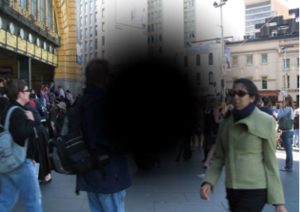
California-based Ocutrx Vision Technologies has developed an augmented reality (AR) headset that helps age-related macular degeneration (AMD) patients overcome severe and devastating vision loss.
Usually occurring on both eyes, AMD is caused by damage to the macula, the 1.5 mm wide, oval-shaped functional center of the retina that is responsible for detailed central vision. In the earlier stages of disease, central vision is reduced, and overall vision distorted. As the disease progresses, all central vision may be lost.
“It’s very frustrating. A lot of people give up reading, they become clinically depressed and withdrawn because they can’t read or see people’s faces,” Michael Freeman, Ocutrx’s founder and president, says in an interview with BioTuesdays.
According to Mr. Freeman, there are 13 million people in the U.S. with advanced AMD, and by 2050, that number is expected to increase to 22 million, affecting some 288 million people worldwide.
“We’re developing the first computer-mediated reality glasses to provide functional vision for people with irreversible vision deficits,” he says, adding that the headset, called Oculenz, was a long time in the making.

“My father was a brigadier general in the U.S. Air Force, and also an entrepreneur. When I was a kid, he bought a computer company, so we grew up building computers. I was working for my dad in the 1990s and we were one of the largest suppliers of computer products in California. I was always trying to tell the technicians, over the phone, what to do to fix computer issues, and I thought ‘if only I could send video over the cell phone, I can show you what I’m talking about,’” he recalls.
The idea led Mr. Freeman to build the first-ever device that enabled streaming mobile video. The invention proved revolutionary: Mr. Freeman won two Emmy awards in 1994 for developing the technology, which continues to be used today to send videos between smartphones.
Then, nearly two decades later, Mr. Freeman’s father was diagnosed with AMD. “He got this disease and had to quit flying and driving. He got us to the Sunday dinner table and said, ‘we invented mobile video and revolutionized the world with that. We know enough about video to figure out some way to work-around this disease,’” he recounts.
Mr. Freeman says the breakthrough came when he bought his father a curved television, a novelty in 2013. He noticed that when his father approached the curved television, he could see more of the image because more visual information was moved to his peripheral vision, which was still functional.
He began working on a headset that incorporated eye tracking and visual field assessment functions to map the defects in the eyes. He then began developing algorithms to alter the image taken by cameras on the headset, to be displayed in the user’s peripheral field of vision.
Mr. Freeman explains that, “The Oculenz takes streaming video of the real world and, within five milliseconds, it alters that image, so text is moved to the left and to the right of the defect, for reading purposes, and images are moved out 360-degrees around the defect, for doing tasks or recognizing faces.” He adds that when using the headset, the brain begins to ignore the visual defect in the image, much the same as it does with the eye’s natural blind spots.
When Mr. Freeman tested the headset on his father, “he was able to read, see faces again and ride the lawn mower. So, he said ‘let’s do this for everybody.’”
Since founding Ocutrx in 2015, the company has collaborated with Karten Design, an award-winning company based in Los Angeles, and Thundercomm, a division of Qualcomm and developer of circuit boards and robotics, to develop the Oculenz prototype.

Mr. Freeman points out that most competitors use waveguide technology, where each pixel in the image and the display are connected by an optical fiber. Using this technology, increasing the headset’s resolution means adding more optical fibers to the already bulky headband, which emits heat and can bring the weight of the headset to more than a pound. The waveguide technology also requires that most ambient light is blocked, so headsets often enclose the eyes and significantly block peripheral vision.
The Oculenz, however, features four million pixels, clear lenses and weighs only 200 grams.
“We believe the Oculenz is best-in-class because it’s the lightest weight, and offers a 120-degree field view, the widest available of comparable products available. It provides the least obstructed vision and the highest resolution; Oculenz has 60 pixels per degree, which is the highest resolution the eye can see at 20/20,” Mr. Freeman contends.
Ocutrx earned Start-Up City Magazine’s recognition as one of the 15 most promising wearable technology start-ups in 2018, and again in 2019. To date, Ocutrx has been granted two patents covering the technology, with seven patents pending, and expects to receive some 30-to-40 additional patents, based on applications they have, and plan to file.
Ocutrx recently completed a pre-pilot clinical trial in AMD patients with 20/200 or poorer vision, some of which had not been able to read for years. In a single visit, patients were provided with headset training, tests of visual function and a self-calibration module to map their area of vision loss.
When using the Oculenz glasses, subjects’ best-corrected visual acuity improved to 20/63, with all subjects able to read 30-point font at a standard reading pace, and some reading text as small as 12-points.
Currently, Ocutrx’s team is optimizing the Oculenz prototype for commercialization. “We’re shrinking everything down to make it quite a bit smaller, from displays of about four-by-four inches wide to displays an eighth the size of a postage stamp,” Mr. Freeman explains, saying Ocutrx is targeting commercial launch for the AMD indication in less than two years.
Ocutrx plans to sell the Oculenz for $6,000, targeting the top low-vision centres and retinal surgeons in major urban areas. Mr. Freeman notes that for the AMD indication, the Oculenz is a generic FDA class I device and 510(k) exempt, therefore it doesn’t require regulatory approval ahead of product sales.
The company is also developing the Oculenz for surgical applications and amblyopia, both applications for which regulatory approval would be required prior to commercialization.
Commonly known as lazy eye, amblyopia affects some 9 million children and adolescents in the U.S. Pediatricians or pediatric ophthalmologists can use the Oculenz’s embedded eye-tracking to generate a report of a patient’s eye movements. This can be used to design custom exercise programs to strengthen the weak eye, while the Oculenz headset “frosts” the dominant eye using dynamic opacity. During therapy, Oculenz generates daily reports of the lazy eye’s rotation that can help experts determine a more exacting course of treatment.

Moreover, the Oculenz includes features that can assist patients with other forms of visual impairment, such as those caused by cataracts and glaucoma.
Ocutrx has incorporated simultaneous localization and mapping, or SLAM, technology into the Oculenz. SLAM, the same technology that is used in autonomous cars, uses sensors to identify and map nearby objects, so the headset can help wearers navigate their surroundings. For example, once the headset has mapped the patient’s home, the voice feature can audibly guide the patient throughout their house, alerting of obstacles to avoid.
The device’s wi-fi and bluetooth capabilities, along with optional cellular connectivity, not only provide similar functionality as a mobile phone, but also enable real-time monitoring. Should the Oculenz detect any changes to an AMD patient’s visual field, or any other changes of concern, the information can be sent to the physician for review. Mr. Freeman says that in the U.S., Medicare and Medicaid will reimburse for this particular monitoring – under particular current procedural terminology, or CPT, codes – to ensure patients are closely monitored while in their own homes.
As for Oculenz’s other applications, the possibilities are endless. “The global augmented reality market will be worth $133-billion in a couple of years, and we’ll be there to provide what everybody is expecting,” says Mr. Freeman.
• • • • •
To connect with Ocutrx, or any of the other companies featured on BioTuesdays, send us an email at [email protected].






